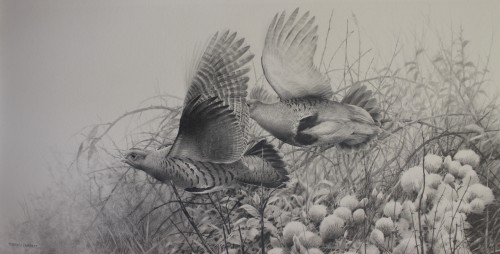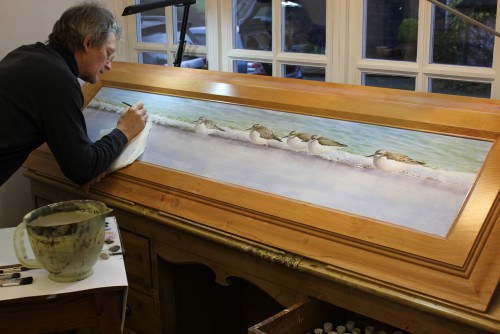Biography and Reviews
A PERSONAL Perspective

Lying belly down on the floor scratching with a pencil on any surface I could find was as much part of my childhood as jumpers for goal posts and scabby knees. The Surrey countryside was my playground. My countryman father was my guide. Before my teens I could put names to most of the birds I encountered. Like all children before me, I collected everything nature had discarded, feathers, bones, butterflies and eggs, all lovingly catalogued in scrapbooks and shoeboxes, and stashed under the bed.
Through my frequent solitary rambles I witnessed the harshness and reality of predator and prey encounters, that later occurred in many of my paintings. I joined the predator pack. Armed with a fishing rod, I pursued every species that swam in the lakes and rivers within bicycle distance from home. It was there I judged the weight of a Kingfisher that used my hand-held cane as a platform to plunge at fry, nipping at the discarded bread crusts floating under my rod. Daily visits eventually led to all-night expeditions. There were times when these extended into whole weeks away from home, having a negative effect on more academic studies. But it was opening my young eyes to many of nature’s secrets, feeding my appetite for new experiences.
With a career as my priority, I spent four years at Guildford School of Art, studying Product Design. Although never employed in the field, it taught me self-discipline and an attention to detail, qualities that have helped in my desire to master the painting craft. The ability to draw with confidence and accuracy is the great liberator allowing the artist’s observation and imagination freedom to create unique images.
So often painters are categorized because of a favoured medium or subject. I have painted birds almost exclusively for 30 years, illustrating the British list three times for various publications, together with a host of foreign species. So it’s hardly surprising that I have been posted in the bird painter’s pigeonhole. When the illustrator’s hat is put on the stand and the Artists ‘Berrie’ is cocked at a jaunty angle, then the pigeonhole can be emptied. After the inspiration of observation in the field, I try to create paintings that are more than just accurately crafted. I hope to show the subject to possess a personality, not any buzzard, but a particular buzzard, that exists beyond the confines of the chosen rectangle. The plants and the props that are part of the painting are not wasted marks of suggestion but are accurate in texture, form and scale.
I am not interested in the accidents made with a chosen pigment. For the last ten years I have worked with both oil and chroma colour (Acrylic) on gessoed canvas. These paintings have given me the greatest freedom, allowing me to boldly cover the whole surface before tackling any detailed work.
These works have freed me from my illustrator’s mind-set, an attitude that said detail was everything. Detail alone does not make a successful painting. Further challenges have come by painting with ink on white scraperboard, working with dilute ink washes and painting from light to dark using a scalpel to scratch into the chalk surface, attempting to recreate the textures of plant and feather. This technique is the finest and most painstaking I undertake. I work on the inks during the mornings because I now find it difficult to focus on the fine point of a scalpel all day.
Exchanging ideas with other painters has been a very important part of my development. Spending a week each year in Gloucestershire at Nature in Art, The national collection of art inspired by nature, has given me valuable opportunities to meet with fellow artists. These exchanges, together with teaching, are opportunities to review methods and ideas and prevent one from becoming formulaic. I have both worked and taught at the museum with Richard Smith, a uniquely extrovert painter who I have unashamedly drained of ideas and techniques since we first met in the late eighties.
Artists are a privileged breed, with many being able to choose where they live and work. For some there are opportunities to travel. I have had the good fortune to have been commissioned on projects that have taken me to some of the world’s most exciting countries. In 1984, while working with The World Pheasant Association, I spent two months in spring and autumn in the Himalayas. climbing to eighteen thousand feet and looking up to the awesome summit of Mt. Everest eleven thousand feet above me. In the same year I walked the deserts of Oman, studying and sketching many desert species while researching a project commissioned by Shell Oil Company. These paintings were given as a gift to the Sultan of Oman and were to become Shell’s 1988 calendar. Although these experiences have influenced many paintings, the core of my output has come as a result of choosing to live in Wales. The diversity of the Mid-Wales landscape is so very unique. Within a thirty minute drive from my studio, I have access to coast and estuary, mountain and moorland and some of the most beautiful river valleys in the whole of the British Isles, all of which are an endless supply of inspiration to me.


